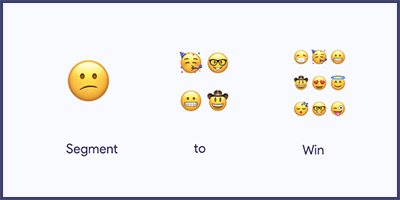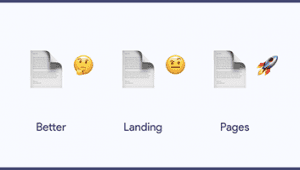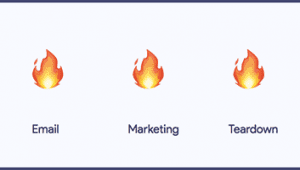How to Increase Conversions With Targeted Email Marketing Campaigns
?
Segment
? ?
? ?
to
? ? ?
? ? ?
? ? ?
Win
I’ve been dabbling in email marketing since 2005.
In those 13 years, the best open rate I ever got for an email was 78%.
Not 78% for a welcome email, an email that typically gets a much higher open rate than other types of emails, nor a content upgrade, an email that delivers a lead magnet directly requested by the subscriber.
No. It was 78% for a regular engagement email sent to thousands of subscribers each week about 14 days after they signup.
And it was an increase of 25% over the previous version…
In this post, I’ll show you how to re-segment automated email campaigns to increase conversions, and perhaps get similar open rates.
What are Targeted Email Marketing Campaigns?
Chances are that if you’re capturing a certain volume of emails each week, the causes of signup will vary from one subscriber to the next.
Maybe some sign up out of curiosity, some are looking for the exact solution your company offers, and some have completely misunderstood the product you’re selling.
The truth is that, even within those groups, you’ll find different profiles and sub-segments.
At Highlights, inbound marketing agencies, pro bloggers and solopreneurs signup to use our product, but we also get signups from folks in large organizations, students, and a fair number of Chinese people for some reason ?.
If we were to send emails to our entire user base (we. never. do. that.), we’d have to write messaging that appeals to all these segments. By trying to appeal to all these segments:
- The benefits would become blend and generic;
- The visuals wouldn’t be as effective;
- The messaging would feel less personal and engaging.
This would, overall, create emails that underperform. Not underperform in absolute terms, but underperform in terms of what they could be.
This is where data segmentation comes in.
When You Should Use Targeted Email Marketing Campaigns
There are two ways to improve the performance of an automated email campaign:
- By optimizing the timing, deliverability, content and open rate of the email;
- By re-segmenting it and creating targeted offers for each segments.
Although Highlights will help with both scenarios ?, doing effective email segmentation adds overhead ?.
There’s the time it takes to create the targeted email marketing campaigns’ segments and copy, but also the future cost of managing a larger email marketing program.

At LANDR Audio, where Ludo and I used to work, we were sending over 300 different emails in 4 languages. On top of these emails, there were also active discussions about adding 2 or 3 more languages. This means that there could be as many as 7 active versions of each email; adding new emails to the core email sequences would multiply the work downstream for the team.
Because of that, re-segmentation was only considered for key emails with proven (and steady) performance. The emails we chose had high send volumes, solid open and click rates, and clear impact on key goals like revenue growth or churn reduction.
Segmenting Your Best Emails to Increase Conversions
Segmentation… sure, but how?
There are four main ways to segment users:
- With Implicit Data: Implicit data is information inferred from other available data. As an example, signups originating from organic channels tend to have higher purchase intent and convert better. Applying this theory to acquisition channel data could help with segmentation.
- Explicit Data: Explicit data is information captured through a form, a survey, or a setup process. The person signing up was aware that he/she was being asked a question and gave a clear answer.
- By User or Buyer Persona: Personas are archetypes or representations of certain user or buyer profiles. We used persona data captured through an email survey (explicit data ☝️) to get that 78% open rate. More on that below ?.
- With a Behavioral Model: Behavioral segmentation leverages transaction and engagement data to create profiles. A popular framework for behavioral segmentation is the RFM (Recency, Frequency, Monetary) framework. A frequent issue with behavioral targeting for email campaigns is that send volumes fluctuate when the engagement is not consistent throughout the year.
With segmentation, less is more.
Although we had access to tons of explicit, implicit, and behavioral data at LANDR, we mostly relied on explicitly-stated personas for targeting. There were clear issues with our persona data (they were based on roles), but it’s what we found that gave us the best balance between simplicity of data collection and accuracy of targeting.
Ultimately, your segmentation criteria might be limited by your analytics setup or the email marketing platform you use.
For Highlights, we send key product events to Intercom, the marketing platform we use for behavioral targeting.
This allows us to send a different personal followup email when things go well…

…and when an account is incomplete…

Subtle, but different. ?
How to Get a 78% Open Rate With Targeted Email Marketing Campaigns
There’s no point in segmenting email campaigns if you’re still going to send the same message to everyone.
If you understand the pain points, benefits and reality of the humans behind your segments, you can adapt your copy to the specific needs focusing specifically on:
- The subject line;
- The preview text;
- Your offer;
- The specific benefits and their descriptions;
- Testimonies and social proof;
- Images or supporting visual assets.
Much like when you design landing pages, you want to use the exact words the people in your segments use to describe their pains and problems.
If you don’t know what those words are, you can use the segments you just created to recruit people for interviews and find out.
We’ll dive deeper into interviews and interviewing techniques in a future post. Sign up to our newsletter to make sure you don’t miss out.
Interested in improving your emails’ performance?
We just launched a SaaS Email Masterclass ? to help increase trial conversions with email.
How to Test & Benchmark Targeted Email Marketing Campaigns
No matter what segmentation approach you use, you’ll want to make sure your segments don’t overlap. This will help you avoid sending different versions of the same emails to the same people.
Unless 100% of your users are covered by the segmentation, you’ll need a fallback email. When a subscriber fits in none of your segments, you can send them the original unsegmented email.
In order to avoid a dip in performance if any of your targeted emails underperform, it’s best to only roll out the targeted email marketing campaigns across a subset of your audience (20 to 30% ideally). This will allow you to test and benchmark segmented performance against your original email template.
As you gain momentum and optimize the targeted emails, you can gradually increase coverage from 30 to 50 to 80 and eventually 100% of your subscribers.
Targeted email marketing campaigns help create a better user experience for your subscribers and increase conversions. This strategy is best used with caution, but it can be a great way to get even more out of your highest-volume emails.





Great Article!